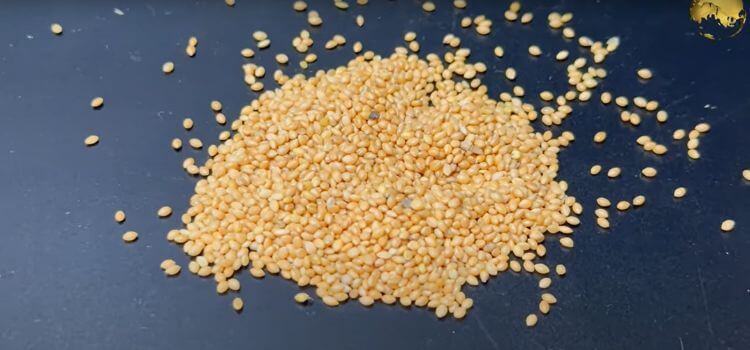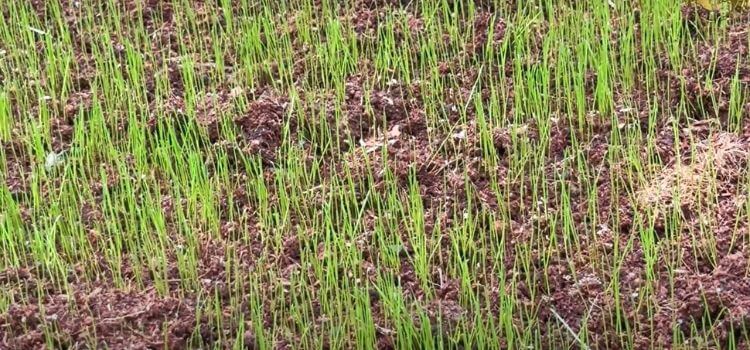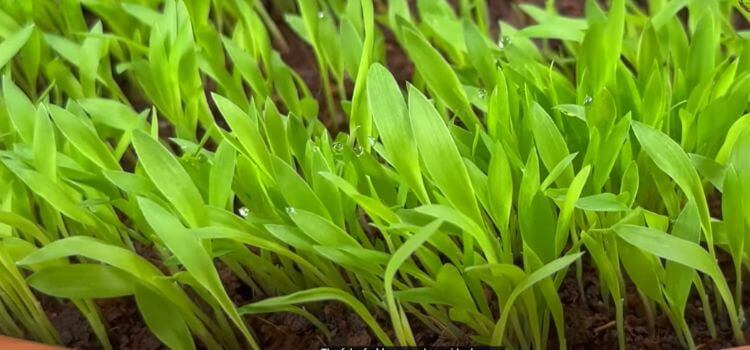As an Amazon Associate, I earn from qualifying purchases.
Straw does protect grass seeds from frost by providing insulation. It acts as a barrier, retaining warmth and moisture.
Ensuring the survival of newly sown grass seed in frosty conditions is a key step towards a vibrant, verdant lawn. Thanks to its insulating properties, straw is a commonly recommended protective layer for fresh seeds. This approach is crucial for gardeners and landscapers striving to establish a yard in challenging environments.
With careful application, straw keeps the soil temperature more consistent, thereby enhancing seed germination and early growth. As the seasons transition and temperatures drop, frost poses a significant threat to delicate seeds.
By utilizing straw, you create a microenvironment favourable for seed survival, giving your grass a head start against the cold. This straightforward technique is both cost-effective and easy to apply, making it a popular choice for ensuring the success of your seeding endeavours.

The Perils Of Frost On New Grass Seed
Sprouting new grass is exciting yet vulnerable. Proper care is crucial. Imagine a blanket of green transforming your lawn. But wait! Frost poses a silent threat to these delicate green shoots. Frost can undo your hard work in a single night, making understanding and prevention key.
Why Frost Is A Threat To Germination
Frost damages new grass seeds even before they sprout. The water inside the seeds can freeze, expanding and bursting cell walls, plummeting the chance of growth. Frost also creates a hard surface that seedlings can’t penetrate, resulting in poor root establishment.
- Seed cell damage: Freezing temperatures harm seed cells.
- Difficulty sprouting: Frost-hardened soil makes seed sprouting tough.
- Water absorption: Seeds struggle to absorb water in frozen soil.
The Delicate Phase Of New Growth
Newly germinated seeds are the toddlers of plant life. Their new roots are short. Their leaves are tender. Frost bites these vulnerable parts. It causes wilting or death. Protection during this delicate phase is paramount.
| Grass Growth Stage | Root Depth | Frost Risk Level |
|---|---|---|
| Germination | Very Shallow | High |
| Establishment | Shallow | Moderate |
| Mature | Deep | Low |
Gardeners use straws to protect germinating grass. Straw works as an insulator, keeping soil temperatures stable and reducing the risk of frost reaching the seeds. Consistent soil temperatures favour steady growth. Straw also helps retain moisture, aiding in successful germination.
When scattering straw, ensure an even layer. An even layer allows light and air movement, which are essential for seed growth. A thin layer is enough; a thick layer might suffocate seeds.
Straw’s Role In Seed Protection
The subtle art of lawn care can sometimes feel overwhelming when it comes to protecting tender grass seeds from the harsh elements. Straw is a traditional protector, acting like a shield for the fragile seeds against the cold bite of frost. Let’s explore how straw keeps newly sown seeds safe and snug during those critical early days of growth.
The Insulating Properties Of Straw
When frost threatens to damage or kill young grass seed, straw’s insulating properties become indispensable. Like a cozy blanket, a layer of straw retains the earth’s natural warmth. This warmth provides a barrier, keeping the ground temperature higher than the air above during frosty nights. With straw, seeds have a chance to germinate in a more forgiving microclimate.
How Straw Application Affects Moisture Levels
Straw protects seeds from cold and regulates moisture. Covering grass seeds with straw helps prevent soil from drying out too quickly, which is crucial because seeds need consistent moisture to sprout successfully.
Straw achieves this by reducing moisture evaporation and shielding the ground from wind and sun. Moreover, straw can also absorb excess water, reducing the risk of seed rot. By maintaining this delicate balance, straw bolsters the chances of healthy, even germination.

Timing Of Grass Seeding And Frost Concerns
As gardeners embrace the onset of cooler weather, grass seed protection becomes a focal point. Understanding how frost can impact the growth of new grass is important. For those with green thumbs, the question lingers: Does straw help during frosty nights? Let’s explore the timing of grass seeding and how to mitigate frost concerns.
Optimal Seeding Windows To Avoid Frost
The right time to plant grass seed is vital for a lush lawn. Optimal seeding minimizes the risk of frost damage. The best time to seed varies by location but usually falls within two key periods.
- Spring: After the last frost, soil temperatures reach about 50-60°F (10-15°C).
- Fall: Six to eight weeks before the first expected frost, giving seeds time to establish.
| Region | Spring Seeding | Fall Seeding |
|---|---|---|
| Northern Zones | May – Early June | Mid-August – September |
| Southern Zones | Mid-March – April | October – November |
It’s important to be aware of local frost dates for successful seeding. Check local guides to pinpoint the right window for your area.
Late-season Seeding Strategies
Did you miss the ideal window? Late-season strategies can still yield positive outcomes. Employing certain tactics ensures successful germination, even when frost threatens.
- Select frost-resistant seed varieties known to thrive in cooler temperatures.
- Apply a light straw mulch layer to retain soil warmth and moisture.
- Monitor weather forecasts for sudden frost and cover the seeded area if necessary.
Straw shields grass seeds against light frost. The key is to maintain coverage without smothering the seeds, ensuring they receive adequate sunlight and air. A thin layer of straw, about 1/4 inch, is enough to protect without hindering growth.
Proper Application Techniques For Straw
Straw serves as a vital shield in protecting new grass seeds from frost. Properly applying straws not only insulates seeds from the cold but also ensures they stay in place, receive adequate water, and have space to grow. Let’s discover how to apply straws effectively.
Calculating The Right Amount Of Straw
It’s crucial to use just enough straw to prevent new seedlings from being smothered. For every 1,000 square feet, you need roughly 50-75 pounds of straw. Use this figure as a baseline and adjust it according to your area size.
Effective Methods For Spreading Straw
Even distribution is key when laying down straw. Break the bales into loose flakes, scattering handfuls evenly across the seeded area. Aim for about 70% ground coverage. Ensure you’ve got a consistent layer that’s not too thick to block light or too thin to expose seeds.
- Gather the necessary tools: Rakes and leaf blowers are perfect for this job.
- Break apart the straw: Make sure it’s fluffed up for easy spreading.
- Apply the straw: Toss it by hand or use a wheelbarrow for large spaces.
- Adjust the coverage: Less is more. Avoid burying the seeds under too much straw.
- Water gently: This anchors the straw and helps with soil contact for the seeds.

Alternatives To Straw For Frost Protection
Protecting grass seed from frost is crucial for a healthy lawn. While straw is a common choice, there are effective alternatives that can shield your seeds from the cold.
Commercial Frost Blankets And Covers
Commercial frost blankets and covers act as a shield against harsh temperatures. These purpose-made materials trap heat while allowing moisture and light to reach the seeds.
- Easy to install, roll them over your seeded area.
- Durable and reusable for multiple seasons.
- Varied thicknesses cater to different levels of frost protection.
Using Mulch And Other Organic Materials
Mulch and other organic materials provide insulation for grass seeds. Materials like wood chips or bark not only maintain soil temperature but also add nutrients as they decompose.
| Material | Benefits | Considerations |
|---|---|---|
| Wood Chips | Insulates soil; reduces weed growth | May attract pests if too thick |
| Leaf Mold | Improves soil structure as it breaks down | Needs to be free of diseased leaves |
| Compost | Offers nutrients; maintains moisture | Should be fully composted to prevent seed burn |
An alternative to straw is to consider the specific needs of your environment and grass type. The goal is to create favourable conditions for seed germination and growth without the risk of frost damage.
Impact Of Straw On Grass Seed Germination
The Impact of Straw on Grass Seed Germination is crucial. Grass seeds need protection against harsh conditions, and frost is a major concern during certain seasons. Straw is a classic method used by gardeners. It shelters the delicate seeds. Let’s explore how straw affects seed germination.
Light And Air Permeability Considerations
Straw has a light, airy structure. This is good for grass seed germination. Light and air reach the seeds easily. Here are some key points:
- Balance is key: Too much straw blocks light and air.
- Right amount: A thin layer allows for sufficient airflow.
- Photosynthesis: This process needs light, so do the straw sparingly.
Potential For Mold And Disease
Using straws also has risks. Moisture can get trapped. Trapped moisture can lead to mould. Mold is bad for growing grass. Here’s what gardeners should know:
| Factor | Effect on Grass Seeds |
|---|---|
| Humidity: | An increase in humidity raises mould risk. |
| Air Flow: | Poor air flow encourages diseases. |
| Wet Straw: | Wet conditions are perfect for mould. |
To prevent this, check the straw. Make sure it is dry and clean before use, and change it if it gets wet. Watch for early signs of disease.
Maintaining The Seedbed Post-frost
As winter wanes, frost’s icy grip can challenge freshly sown grass seeds. A layer of straw protects these seeds, but careful maintenance after the frost is required to ensure a lush, green lawn.
Post-frost Care For The Straw-covered Seedbed
Check straw coverage after the frost to ensure seeds remain shielded from harsh elements. Replace any displaced straw to maintain consistent protection.
Keep the seedbed moist but not waterlogged. Too much moisture can harm emerging seedlings.
Avoid walking on the seeded area to prevent compressing soil and damaging tender sprouts.
Signs Of Successful Germination After Frost
- Observe for small green shoots pushing through the straw, an initial sign of successful germination.
- Uniform growth throughout the bed indicates even protection and germination.
- Ideal germination occurs when temperatures stay consistently above 50°F (10°C).
Frequently Asked Questions On Does Straw Protect Grass Seed From Frost
Straw acts as an insulating layer, trapping heat from the soil and shielding grass seeds from the cold. Covering seeds with straw minimizes frost damage and enhances germination rates in cold conditions.
Yes, straw is effective at keeping grass seeds warm. It retains soil warmth, preventing the seedlings from freezing during winter and supporting their growth even in cold weather.
For optimal protection, aim for a straw layer about 1-2 inches thick. This thickness provides sufficient insulation without smothering the seeds, allowing for light penetration and air circulation.
Yes, the type of straw can matter. Wheat, barley, or oat straw is commonly used because it is less likely to introduce weeds. It also provides uniform coverage and is easy to remove once the grass is established.
Conclusion
To wrap up, using a straw to shield your grass seed from frost is smart and effective. This time-tested method balances insulation with breathability. Don’t forget—timing and coverage are key. As you plan for a lush lawn, remember that protection from frost is a crucial step for seedling success.

